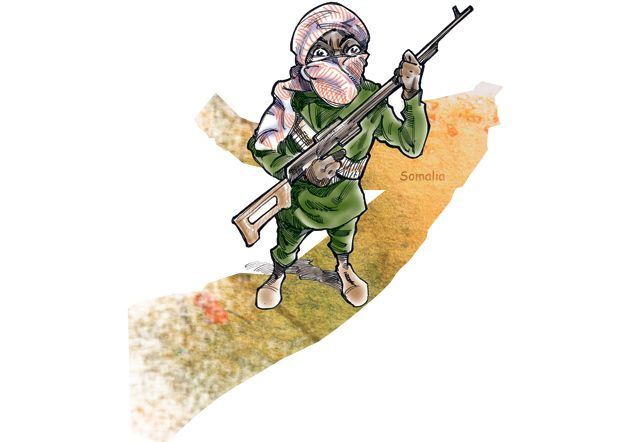The US administration sees this action as key to the success of its ‘war on terror' and on Al Qaida in particular. A Taliban/Al Qaida victory in Afghanistan would quickly spill over the border into Pakistan with disastrous consequences for US hegemony, Israel and homeland security.
With all eyes on the Hindu Kush, however, there is a marked failure to recognise the myriad dangers brewing in Somalia which has been torn apart by civil war for nearly 20 years and where the Islamist group, Al Shabab and its allies, are now in control of most of southern and central Somalia.
The beleaguered, US-backed, Transitional Federal Government led by President Shaikh Sharif Shaikh Ahmad, now only controls parts of Mogadishu with the help of 4,300 African Union (AU) peacekeeping troops.
The failed state is considered the most dangerous place in the world — ideal territory for Al Qaida.
Al Qaida has long had a presence in Somalia. When I interviewed Osama Bin Laden in 1996, he revealed that some of his men had taken part in the 1993 attack on US Black Hawk helicopters in Mogadishu.
The attack, led by Somali war lord General Mohammad Farrah Aidid, brought two helicopters down, killing 18 US soldiers and injuring 73.
The bodies of dead soldiers were dragged through the streets of Mogadishu in one of the most humiliating chapters in US military history. Al Qaida's strategy for survival and expansion follows a clear pattern.
The organisation forms alliances with ideologically close indigenous groups in failed states who can offer its fighters protection and a safe haven. In exchange, Al Qaida provides military muscle, strategic advice and training.
When US-backed (or instigated) military action succeeds in dislodging them from a stronghold, large numbers of Al Qaida fighters migrate to another sanctuary — often temporarily.
In Iraq, Al Qaida joined forces with the indigenous insurgency until the US countered with its ‘Awakening' programme followed by the January 2007 military ‘Surge'. Al Qaida fighters and leaders left in their hundreds (taking some of Saddam's Republican Guard explosives experts with them) to resurface in Afghanistan and Pakistan.
On February 11, 2007, Dr Ayman Al Zawahiri (the deputy leader of Al Qaida), made a broadcast exhorting the mujahideen to join the Taliban's fight against Nato under the leadership of the ‘Commander of the Faithful', Mullah Omar to whom, he announced, he had given his bayat. When the US withdrew their troops from the major Iraqi cities on July 1 2009, significant numbers of Al Qaida fighters returned, as subsequent attacks on high-profile targets attest — August's bombings within the Green Zone, for example, which killed upwards of 75 and wounded 300.
Now that the US and Pakistan are intensifying their bombardments on Al Qaida and Taliban strongholds in the Hindu Kush, there have been reports of large numbers of Al Qaida fighters arriving in Somalia where they are allied with Al Shabab.
Strategic haven
Al Shabab was formerly the hardline militant youth wing of the Islamic Courts Union which seized control of Southern Somalia from June to December 2006.
In September 2009 Al Shabab leader Ahmad Abdi Godane (also known as Abu Zubayr) formally pledged his organisation's allegiance to Al Qaida in a video titled ‘At Your Service Osama'.
In August US Secretary of State, Hillary Clinton, met with Somali president Shaikh Sharif Shaikh Ahmad. After the meeting she concluded, ‘If Al Shabab were to obtain a haven in Somalia which could then attract Al Qaida and other terrorist actors, it would be a threat to the United States.'
Located on the Horn of Africa, at the gateway to the Red Sea, Somalia is also of great strategic importance. In Yemen, on the opposite coast, Al Qaida already enjoys significant support — Osama Bin Laden is of Yemeni origin.
The West has apparently been at a loss as to how it should ‘deal with' Somalia which is becoming a crucial testing ground for Obama's foreign policy. The US has little appetite to repeat the Black Hawk Down debacle which forced then US president Bill Clinton to order an immediate withdrawal of troops from Mogadishu and in the recent past has relied on ‘proxies' to deal with Somalian crises — Ethiopian troops demolished the Islamic Courts Union in December 2006 for example.
In June 2009 the Obama administration confirmed that it sent 40 tons of arms and ammunition to Ahmad's forces and, improbably, $2million (Dh7.34 million) cash in a paper bag. US gunboats have been patrolling the coast, mostly in a bid to control rampant piracy.
September brought a more ‘hands-on' approach, however, when six Black Hawk helicopters were deployed against Al Qaida targets, killing one of the organisation's leaders, Saleh Ali Saleh Nabhan.
Retaliatation — in the form of a twin suicide bombing at the AU base — was swift. Significantly, responsibility for the attack was claimed by Al Shabab whose spokesman spoke of ‘revenge for our brother Nabhan'.
If the US were to be drawn into a lengthy military engagement in Somalia in its bid to defeat Al Qaida, it would mean a third un-winnable war of attrition for the superpower whose resources (in terms of troops and finances) are already stretched to breaking point by its commitments in Iraq and Afghanistan.
Abdel Bari Atwan is editor of the pan-Arab newspaper Al Quds Al Arabi.











